This request seems a bit unusual, so we need to confirm that you’re human. Please press and hold the button until it turns completely green. Thank you for your cooperation!
Blog
-
Just a moment…
Just a moment… -
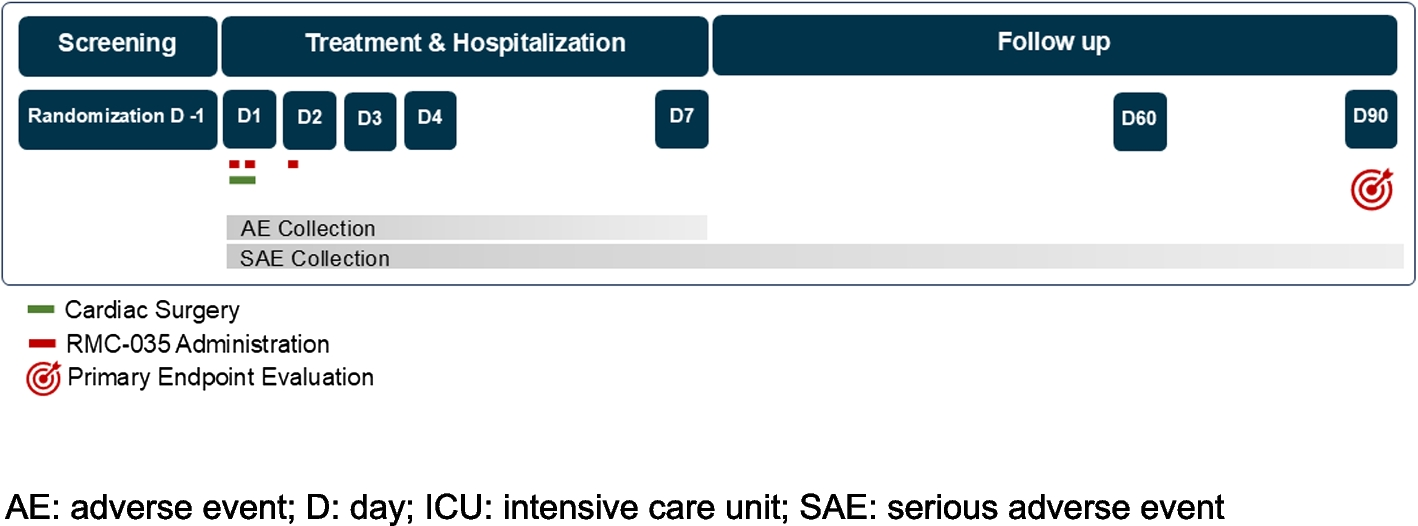
POINTER: study protocol for a phase 2b, randomised, placebo-controlled, double-blind, parallel group dose-finding clinical study to evaluate the efficacy of RMC-035 on renal function and safety, in participants at high risk for kidney injury, following open-chest cardiac surgery | Trials
Explanation for the choice of comparators {6b}
The double-blind placebo-controlled design allows for an unbiased assessment of efficacy and safety. The use of placebo is justified by the intent to assess absolute efficacy and safety of RMC-035 and…
Continue Reading
-
How Agentic AI is enabling autonomous systems to learn and grow
Learn about the difference between an AI agent and Agentic AI – and how a range of these solutions are transforming energy production.
Agentic AI heralds a new era of artificial intelligence, where AI agents are the building blocks within an ‘agentic framework’. Agentic AI is a system that knows the goal of the user and operates using real-time data to coordinate a team of AI agents to achieve that desired aim. Here, Daniela George and Sebastiano Barbarino discuss what that means in the context of energy – and how they and their human teams are advancing Agentic AI for Baker Hughes customers.
Daniela George, Strategy & Business Development Director, Industrial Solutions, Baker Hughes “When I explain agentic AI, I talk about the entirety of the framework of what it means to act autonomously – to have these artificial intelligence systems that can think for themselves and can execute different tasks with minimal training or human intervention. As opposed to more traditional AI, which has predefined rules, Agentic AI perceives that context and thinks about reasons for next steps.
Agentic AI doesn’t just follow predefined rules; it reasons, adapts, and acts toward desired outcomes, including taking actions. Agentic AI will continuously reason its way through problems in order to achieve a certain task or goal.
Cordant™ is a modular, AI-enabled industrial enterprise solution that optimizes assets, processes, and energy use at scale. Acting as a digital thread across operations, Cordant™ automates decision-making, enhances reliability, and supports sustainability — elevating operational data from plant-level tools to strategic, enterprise-wide impact.
In the context of what we do with Cordant™, Agentic AI is about helping operators of industrial facilities transform the way they work. From a Cordant™ standpoint, it’s about the operational transformation that has to happen on the autonomous workflow side. It’s about automating the daily processes that occur within a facility or a plant. It’s also about strategic agility in dashboarding, doing root-cause analysis faster, prioritizing alerts – all the things that are very manual today can have AI agents created within an Agentic AI framework that can accomplish those tasks autonomously. The result is freeing up human experts to do additional value-added tasks.
I’m on the Partnerships & Alliances team and we support the Cordant™ product and technology team by working with partners who help us identify opportunities to build these Agentic AI capabilities and ultimately achieve this transformation and agility.
Sebastiano Barbarino, Digital Production Solutions Leader, Baker Hughes Imagine each AI agent is there to automate a task that the engineers are doing. For example, the engineers sit down in the morning and see they need to fix a model – we create an agent that helps them do that. We also create an agent that follows up an engineer’s daily and weekly to-do lists. It even knows how to check for and verify impact.
From those agents and others, you create a multi-agent system, which is able to talk between the agents. This collaboration between agents enhances the large language model’s (LLM) reasoning capabilities and reduces hallucinations. Agentic AI accelerates adoption of recommendations because it mimics human interaction dynamics.
Using A2A – agent to agent – protocol, we enable multiple agents to collaborate across different technology stacks even from different vendors or created by our own customers, to make more informed decisions. Agentic AI is when you put all these agents in a single infrastructure – a Model Context Protocol – MCP – and streamline their ability to connect with external tools and data sets.
Engineered to optimize oil and gas operations through AI-driven automation, real-time data integration, and smart decision-making, the Leucipa™ automated field production solution is the industry’s leading digital production software. With seamless field data connectivity, streamlined workflows, and actionable data insights and recommendations, Leucipa allows operators to take control of their operations across artificial lift, chemical management, power systems, and reservoir performance.
The way we have been using AI in our Leucipa solution so far has been traditional AI, Machine Learning, and over the past couple of years, LLMs and GenAI like traditional chatbots but in the engineering context. Importantly, it has all been paired with our deep engineering physics. Our Leucipa Production Assistant – we call it ‘Lucy’ – has already been helping engineers make better decisions.
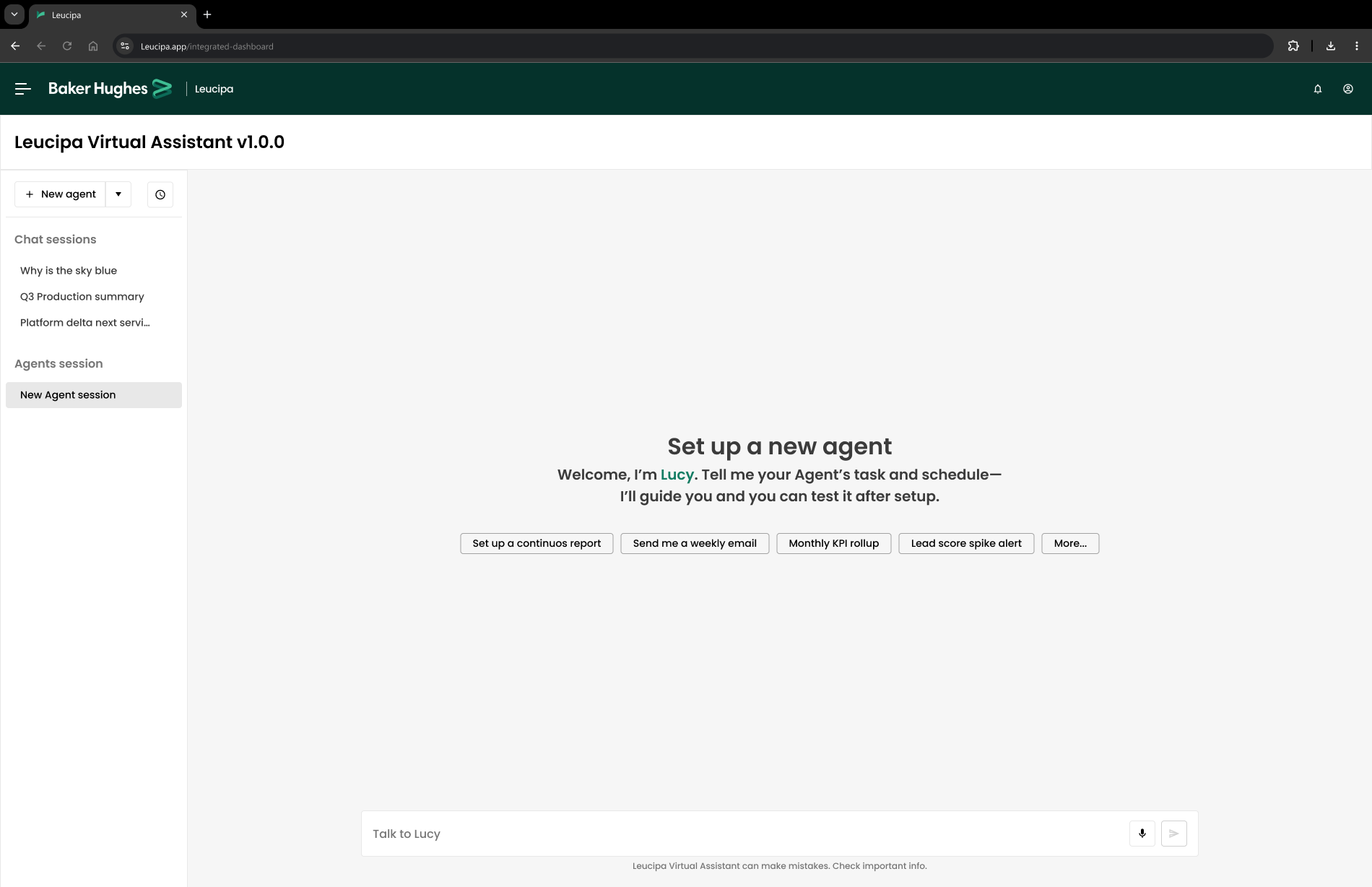
Introduction screen when setting up a new agent in the Leucipa platform Once ‘Lucy’ has made a recommendation and the human engineer has made a decision, we have now created an exception-based monitoring agent “to watch” whether the decision is leading to the expected results. For example, you have made a well intervention and you want to see if it is increasing or decreasing production. For a human to make that assessment, you would need the engineer to watch the screen constantly to monitor the production across thousands of wells.
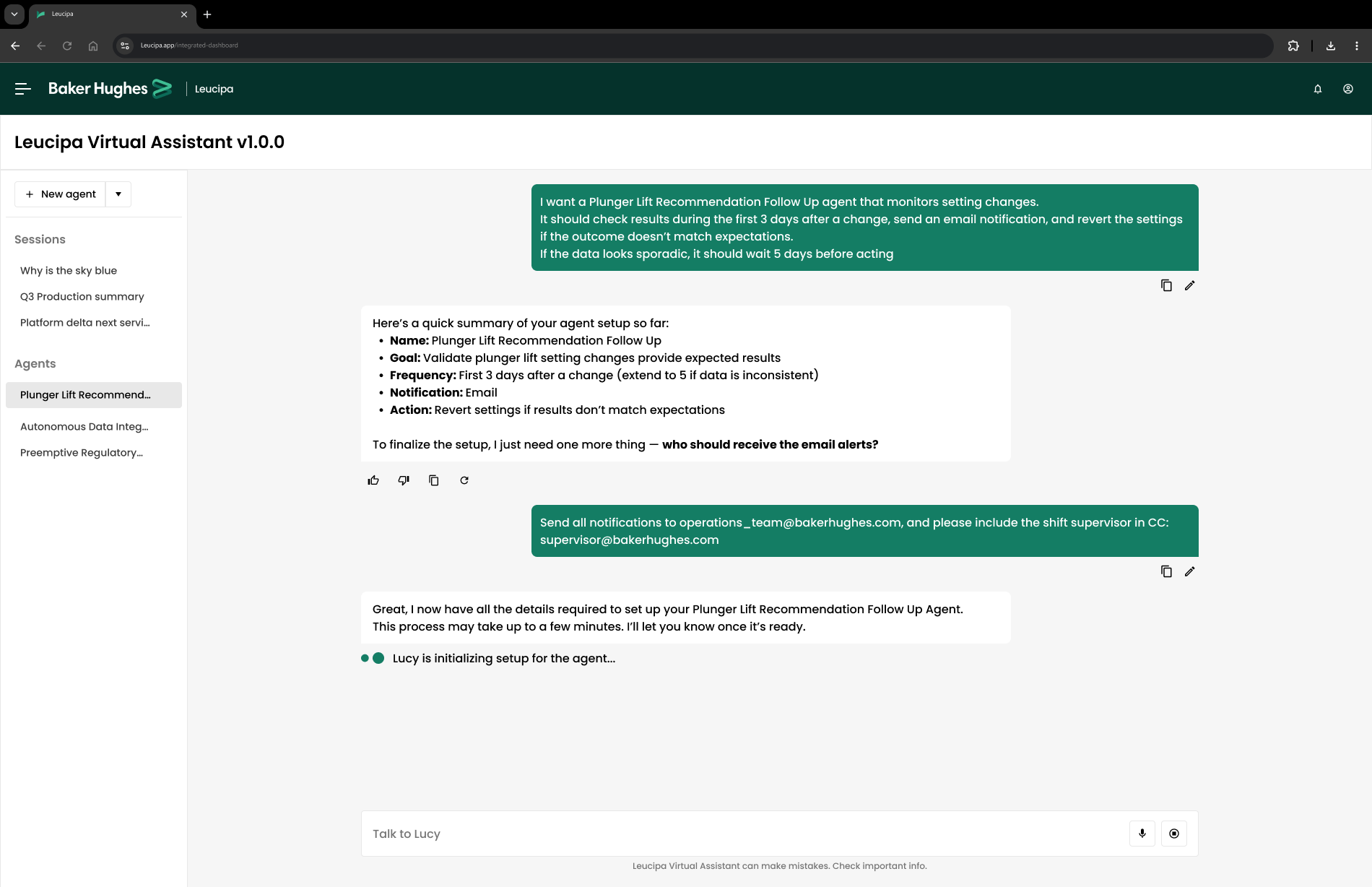
Using these GenAI agents an engineer can instruct it in natural language – across multiple languages – ‘I made this decision, and I expect this result: watch it for me’. The AI agent then runs 24/7 and comes back in due course to give the engineer recommendations on what can be done next to further optimize production. It doesn’t just show you problems, it refactors the solutions for you. One AI agent can watch thousands of wells across thousands of tasks. I can ask the same agent to check data quality across all those same wells every day.
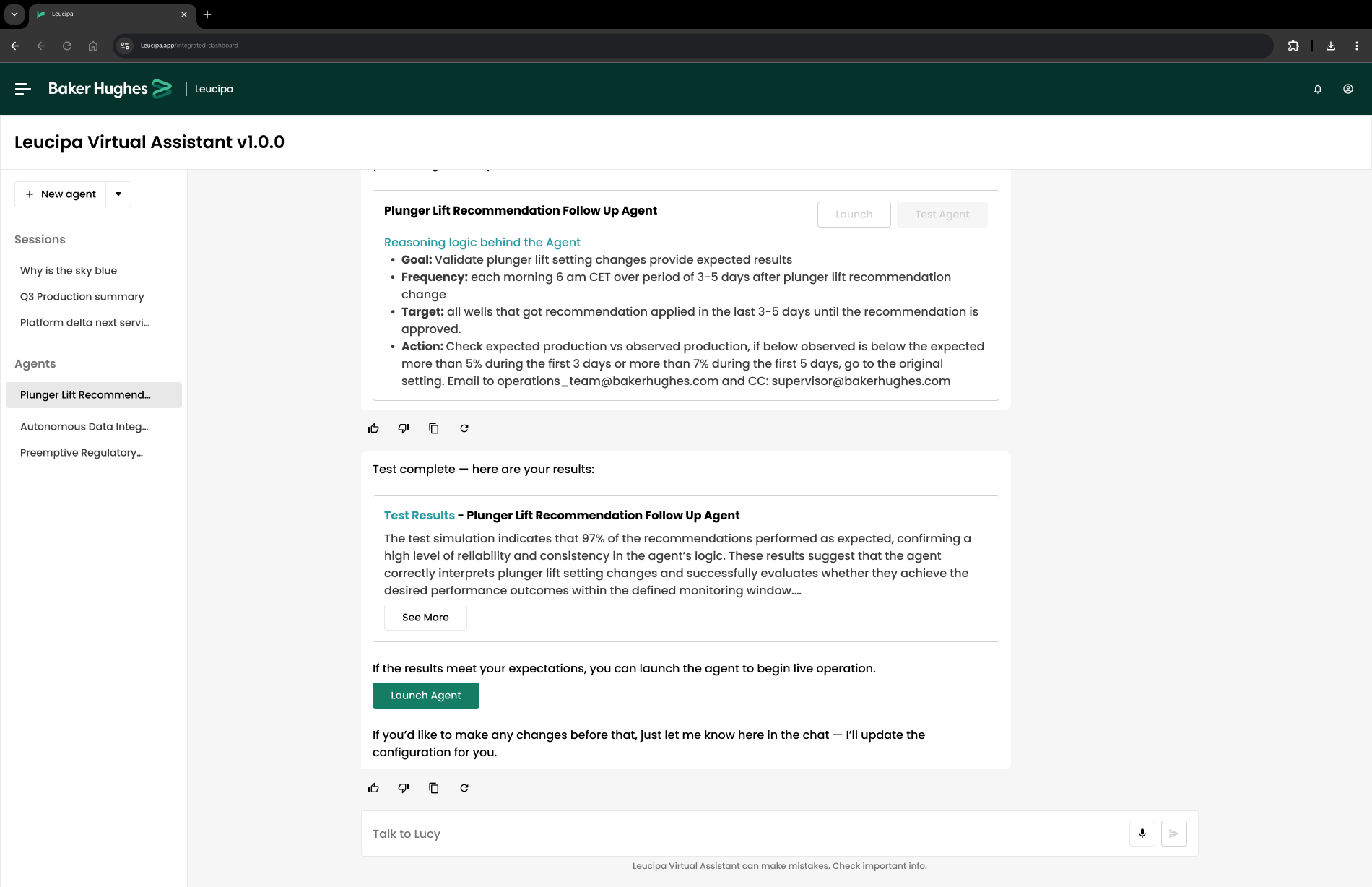
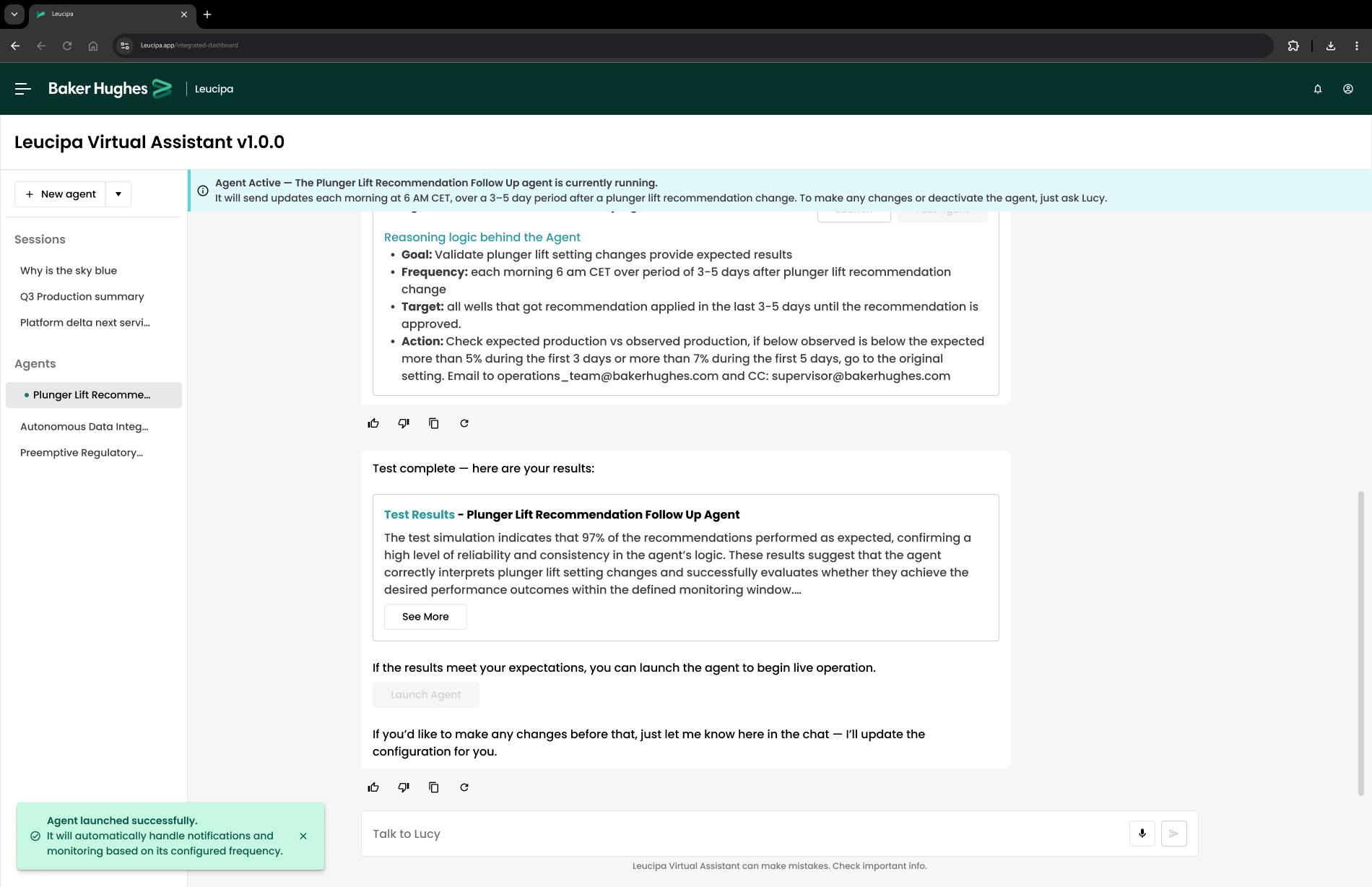
And that’s just an example of one agent. The beauty of Agentic AI is that it can bring multiple agents together to communicate and learn. This will further optimize processes in Enterprise applications via an Orchestrator agent to manage complex workflows utilizing AI agents with expertise in particular tasks or fields. The Orchestrator agent will oversee a team made up of both digital and human agents, with enhanced interoperability achieved by a new agent-to-agent communication protocol.
96% of enterprises plan to expand their use of agentic AI in the next 12 months. [cloudera.com]
By 2034, the global agentic AI market could reach $200B, with financial services leading adoption. [tradersmagazine.com]
Operational cost reductions of 30% and productivity gains of 20–60% are reported. [landbase.com]
Rather than being personalized for each customer, Agentic AI needs to be customized to each type of persona – the type of user who is engaging with it. For example, with Cordant™ it could be an operator controlling the facility, a project manager, an engineer or even someone at an executive level. Those user personas are going to be wildly different in how they utilize Cordant™ and therefore they will have different needs from Agentic AI capabilities. Depending on a particular process in a facility there could be cases where it might be customized, but the most important aspect will be aligning the Agentic AI framework with the goals of the users, which are likely to be similar across customers.
For example, let’s think about an operator with a goal of increasing the total production of a plant by 10%. Cordant™ has different pillars, such as Asset Health, Asset Strategy and Process Optimization. To manually accomplish that goal, even with some predefined traditional AI rules, would take a lot of time to analyze and iterate different scenarios.
Click on the image above to navigate the full suite of solutions
Agentic AI capability allows the system to continuously learn and adapt. If you tweak one parameter of your processing facility – perhaps you increase the runtime of a certain pump, for example to see if you can get more production for a certain period of time without impacting your asset maintenance schedule or your strategy risk. Those are the kind of things that Agentic AI capability can automatically determine for an operator, as opposed to a traditional AI method that would hit a predefined rule and have to go back to the start to reassess. I see the biggest value to a user in the way Agentic AI can interrogate multiple agents to test how to reach those goals by tweaking different parameters.
Agentic AI can make different suggestions, including based on what it’s learning from the feedback it gets from the human users as well as the other AI agents. It can suggest parameters and tweaks that perhaps an operator had previously thought were too risky. Agentic AI can bring together vast amounts of data from across its network of agents and trigger deterministic calculations within its suite of MCP tools to safely generate results and deliver the goals.
Another helpful case where Cordant™ is looking at Agentic AI as a reliability advisor where each AI agent will focus on one specific task – one for process optimization, one for asset strategy, one for asset health. Ultimately, they talk to one another to accomplish certain goals. Cordant™ allows for a plant to be interconnected in a way that has never happened before. It means you can generate more production without compromising maintenance or risking running equipment into the ground or causing other issues. All the AI agents have their expertise in each part and ultimately come together to make recommendations to transform operations from reactive to proactive through self-directed reasoning agents.
For Leucipa, we are already implementing early Agentic AI solutions with multiple customers to show the value, and it is growing very fast. The ability to use natural language – and multiple languages – will vastly change the way customers interact with our applications. They won’t need to navigate through dashboards to see KPIs and other information. Our agents will proactively tell you what the problems are and how you can fix them. It is more open and will be more efficient for our customers’ engineers – and will in turn enhance their job.
It comes back to being able to move from manual tasks to more value-added types of work. A big part of adoption will be building trust in Agentic AI systems to allow them to make some of these decisions – the management of industrial facilities and plants is very demanding. Having a technology that can be a trusted assistant to advise and give well evidenced recommendations is very important and empowering.
The challenge that any technology faces is building trust in users. If you don’t build trust, they will never use it even if they’ve bought it. That’s why Cordant™ calls our solution an advisor: we are not in the business of replacing the deep expertise that each customer has in their own company. We just want to help them make decisions faster, based on more and better data which will produce accurate evidence, diagnoses, and supporting recommendations, ultimately helping skilled engineers get to desired outcomes more quickly.
As Daniela says, it’s important to understand that this technology is not going to replace people. It is the other way around: this technology supports the engineers to make better decisions, faster and to make more decisions during the day around production optimization. That is the vision we have for Leucipa and Agentic AI. You cannot replace the engineering mind behind those decisions – the tools we are putting inside Leucipa – are not engineers. Agents are simply tools to aid better engineering decisions.
Continue Reading
-

How to cancel your HBO Max subscription
It keeps happening. HBO Max , around 16 months . If your debit card is feeling the pain, or if you’re just not excited about that weird nobody asked for, you may decide to take a break from the . Here’s everything you need to know about…
Continue Reading
-
US kills 14 in strikes on alleged Pacific drug boats: Pentagon chief – Dawn
- US kills 14 in strikes on alleged Pacific drug boats: Pentagon chief Dawn
- US kills 14 in strikes on four alleged drug boats in Pacific BBC
- Agriculture secretary accused of unlawfully refusing to use emergency fund to prevent food stamp disruption…
Continue Reading
-
You have your America, I have my America
WASHINGTON WATCH
A century ago, Gibran Khalil Gibran wrote a love poem to Lebanon, “You have your Lebanon, I have my Lebanon.” He spoke of his affection for the captivating qualities of generosity and hospitality of the Lebanese people and…
Continue Reading
-

The Profit of Preparedness: Resilience in Supply Chains, Finance, and AI
After an unprecedented summer marked by intense heatwaves, devastating floods, and disrupted logistics, the concept of resilience has become more than just a theoretical idea; it’s now a critical concern for boardrooms and a balance-sheet question. The dialogue has evolved from simply asking, “How do we demonstrate responsibility?” to a more pressing question: “How can we accurately quantify and account for climate-related costs at the product level, rather than letting these costs slip through the cracks?”
COP30 in Brazil stands out as a pivotal moment where global challenges and the need for a transition come into focus. The leaders keeping an eye on aren’t just those making sweeping promises, but rather those integrating resilience into their core business operations, across supply chains, finance, and with the help of AI.
These three value drivers are where sustainability equals ROI:
1. Supply chains, where your resilience is tested first
Supply chains are where the operational reality of disruptions plays out. Shipment reroutes, altered deadlines, and rising raw material costs translate to balance sheets as premiums, downtime, and cashflow.
Companies are feeling the impact: more than half of firms surveyed by Morgan Stanley experienced climate impacts on operations within the past year, including increased costs, worker disturbance, and revenue losses. BCG estimates that climate-related supply chain disruptions already cost companies an average of $182 million annually.
These shocks are not abstract. When a drought shrank the River Rhine in 2022, shipping capacity fell by half, forcing costly reroutes for European manufacturers. US agribusiness faced similar disruptions when the Mississippi River levels dropped from 2022-2023, delaying exports and inflating logistics costs.
As climate adaptation and mitigation climb up corporate priority lists, the agenda of today’s COO is shifting. Here’s my view on the key steps that unlock the real business value of sustainability:
- Gain full visibility. Investing in tools that increase traceability and real-time awareness of emissions and resources is crucial; this will allow you to pinpoint vulnerabilities, diversify sourcing, strengthen transparency and anticipate risks before they escalate.
- Link resilience metrics to measurable outcomes. Your value chain is your source of measurable sustainability value. Metrics that go beyond avoiding losses (i.e. reduced insurance premiums, increased operational agility, customer trust) turn this visibility into actionable insight. SAP Customer Nestlé has strengthened their resilience with real-time, connected operations across its global supply chain with a cloud-first environment and integrated analytics.
With tools in place and metrics aligned to outcomes, COOs can optimize value chains beyond just efficiency: diversifying suppliers in geographies with higher exposure to disruptions, building redundancy where needed, and securing future advantage.
Resilience isn’t just defensive. A supply chain that adapts faster than your competitors’ is a growth driver. Redesigned value chains and networks transform risk management into a source of long-term ROI, and sustainability data is an untapped lever.
2. Finance, the place climate risk becomes line-item reality
If supply chains are where vulnerabilities show up operationally, finance is where they land with impact and finality. Today’s CFO cannot steer the business on carbon numbers alone. Making this shift means answering questions like:
- “How do we integrate sustainability data into the same systems that manage profit centers, cost centers, and balance sheets?” Many disclosures still rely on proxy data, such as industry averages, which can result in deviations of 30-40% or more from real values. SAP Green Ledger brings granular carbon insights into core finance processes, enabling organizations to drive decarbonization and operationalize sustainability at scale. This means companies can understand not only how much carbon they emit, but also how it affects risk exposure and margins.
- “How do we measure progress toward decarbonization goals to strengthen our position in carbon-sensitive markets?” Those with verifiable sustainability data have preferential access to capital. Sustainable bonds and loans surpassed $1.6 trillion in 2024 as demonstrable decarbonization strategies often lowered financing costs.
Companies that treat sustainability data as a financial asset, connected to auditable accounting principles, are transforming sustainability from a compliance exercise into a growth driver.
The organizations that get this right are already lowering the cost of capital and outperforming their peers.
3. AI, your resilience accelerator
AI plus sustainability is a classic ROI equation. One type of return on investment is how much better you get at predicting physical climate risk, then prepare and respond with speed and agility. According to McKinsey, AI (especially generative AI) could generate $2.6 to $4.4 trillion annually in economic benefits, and up to $6.1 to $7.9 trillion when considering full productivity impact across industries.
However, there is a gap between AI adoption and opportunity. According to Accenture, only 14% of companies today are using AI to reduce their carbon emissions, but 65% believe they will do this in the future.
Opportunities for AI adoption to drive ROI and drive competitive advantage are huge:
AI streamlines supplier data, automatically handles permits, and reduces compliance costs. SAP capabilities such as AI-assisted permit management and AI-assisted compliance information processing improve speed and accuracy of information extraction and processing, while AI-assisted ESG report generation allows you to report on your progress in minutes. Automotive industry company Martur Fompak has used business AI to achieve a 52% reduction in transportation-related carbon emissions and to calculate carbon footprints more than 50 times faster. Another example is msg Global Solutions AG, whose Greenwashing Detector solution leverages generative AI to validate reports and detect potential greenwashing.
Unlock enterprise-wide intelligence for long-term ROI
For companies that go a step further to deeply ingrain AI implementation, AI contextualizes and integrates sustainability data across ERP systems to inform decisions on risk, resilience, and opportunity. Tools like AI-enabled supplier validation, AI-powered emissions factor mapping, and AI-assisted carbon emission analysis help identify risk and opportunity so that you can act on sustainability across the enterprise. This drives both day-to-day operations, like smarter procurement, as well as long-term strategy, like identifying and reducing emissions at the source.
In times of disruption, the early mover captures the value. AI isn’t just an efficiency tool, but a proactive warning system enabling you to see risk sooner, act faster, and optimize better.
Climate risk doesn’t live in theory. It shows up in supply chains, operations, and increasingly, line items on financial statements. Resilience is no longer just a safeguard, but a source of growth, efficiency, and competitive edge.
At COP30, leaders across different industries are preparing for a new normal, focusing on managing environmental, regulatory, and market risks as their top investment priorities.
More information about SAP Sustainability can be found here.
Continue Reading
-
Just a moment…
Just a moment… This request seems a bit unusual, so we need to confirm that you’re human. Please press and hold the button until it turns completely green. Thank you for your cooperation!
Continue Reading
-

Brits go big on holidays abroad, spending almost £3,000 on a once in a lifetime trip
- Research by Aviva reveals just under half (49%) of Brits have been on a once in a lifetime trip, spending an average of £2,807 per person[1]
- Beach holidays prove to be the most popular for such occasions (25%), but a handful (6%) of travellers have visited somewhere considered unsafe or dangerous
- Brits are also celebrating milestone events abroad – with almost half (49%) spending a birthday abroad or planning to do so in the future
- Despite this, 11% of those travelling this year do not plan to purchase travel insurance[2]
New research by Aviva reveals that Brits are prepared to go big on trips abroad, with almost half (49%) having been on a trip of a lifetime, at an average cost of £2,807 per person.
And for some, these special trips aren’t a one off as one in 10 (10%) have been on three ‘once in a lifetime trips’ or more, spending as much as £3,040 on their most recent trip.
Beach holidays (25%) prove to be the most popular for once in a lifetime trips, followed by city breaks, touring holidays and cruises (all 15%) and trips to theme parks/ adventure parks (12%). The research also reveals that a handful of people (6%) may have an appetite for so-called ‘shock tourism’, having deliberately visited somewhere unsafe or high-risk, such as a location with a live volcano.
The research also reveals that Brits are prepared to go all out celebrating milestones abroad. According to the findings, almost half (49%) have either travelled abroad – or are planning to – for a birthday, at an estimated average cost of £1,606 per person.
Europe tops the list for birthday celebrations, with Spain being the most popular country, followed by Greece, Italy and France. However, the United States also proves to be a well-liked destination, with a handful of travellers heading to further afield destinations such as Ghana, Fiji, Kenya, Malawi, Tobago, and Costa Rica.
Although birthdays prove to be the most common reason for celebrating abroad, the data also reveals that Brits are heading overseas for family reunions (34%), other people’s weddings (32%) and anniversaries (31%).
Milestone moment
Percentage who have either travelled abroad for this moment or plan to do so in the future
Average spend / planned spend[3]
A birthday
49%
£1,606
A family reunion or trip
34%
£1,813
A wedding (someone else’s)
32%
£1,681
An anniversary
31%
£1,844
A sporting event
29%
£1,492
A music or arts event
27%
£1,440
A sabbatical or extended holiday
24%
£2,226
A religious event or festival
22%
£1,694
A wedding (your own)
22%
£2,605
End of exams or graduation
21%
£1,528
To take part in a sporting event
19%
£1,668
Renewing wedding vows
19%
£1,879
A gap year
18%
£1,879
Retirement (out of those aged 66 and older)
17%
£1,901
A birth or adoption of a baby
16%
£1,973
A babymoon
15%
£1,791
Any holiday, whether it’s to celebrate a birthday, anniversary or even retirement, is exciting. While we hope everything goes smoothly, life events such as illness, injury or even being called up for jury service can impact our ability to travel, which is why travel insurance is so important.
Travellers are also willing to invest in other major life events, spending an average of £2,605 on their own wedding, £2,226 on sabbaticals or extended holidays, and £1,973 on the birth or adoption of a child.
Despite this, 11% of those who are planning to travel this year do not plan to take out travel insurance[2].
James Devereux, Travel Manager at Aviva, says: “It’s interesting to see that Brits are taking the chance to go abroad for those once in a lifetime trips or milestone moments.
“Any holiday, whether it’s to celebrate a birthday, anniversary or even retirement, is exciting. While we hope everything goes smoothly, life events such as illness, injury or even being called up for jury service can impact our ability to travel, which is why travel insurance is so important.
“Not only does it provide cover in the event you need to cancel your trip, it can also protect you while you’re away if you’re unfortunate enough to fall ill and require medical assistance or other support. Travel insurance can give you that much needed peace of mind while celebrating a special time.
“However, it is worrying that some travellers are visiting destinations that are deemed dangerous or high risk – otherwise known as ‘shock tourism’. If the government advises against all travel, but you choose to go anyway, you wouldn’t be able to make a claim in the event you needed medical assistance, for example. With medical bills in some countries costing tens – if not hundreds – of thousands of pounds, it’s important to check the FCDO website before you travel.”
Aviva’s dos and don’ts for ‘once in a lifetime’ and milestone holidays:
DO check your policy for a maximum trip limit – If you are looking to go on a sabbatical or extended holiday, be sure to check your travel insurance as there is usually a limit on the number of consecutive days covered. In many instances, this is usually around 31 days, although policy extensions can usually be added at a fee.
DO double check you’re covered for any activities planned – Some holidaymakers might be planning something special for their milestone trip, which may not be covered by standard travel insurance policies.
DON’T travel without declaring any medical conditions – Be sure to inform your insurer about any existing or ongoing medical conditions, whether they relate to you or anyone else covered by the policy. Some insurers may also require you to update them if your health changes between the time you purchase the policy, book your trip and leave for your holiday. As requirements can differ between providers, it’s always wise to check directly with your insurer if you’re unsure.
DON’T travel against government travel advice – If the Foreign, Commonwealth & Development Office (FCDO) advises against all travel, but you decide to travel anyway, you probably wouldn’t be able to make a claim should you require things like medical treatment or assistance while abroad. Though it may sound obvious, rules change frequently, so it’s worth keeping an eye on both the government website and any local government services for any particular advice before you travel.
DO check the policy limit – If you’re planning on spending thousands on a dream holiday, it’s a good idea to double-check your policy limit – which is the maximum amount an insurer will pay for claims covered – to ensure that it provides the right level of cover in the event you need to cancel your trip. Policy limits will range across insurers, so if unsure, always contact your insurer directly.
DO check entry requirements – Under new rules, British passport owners may have to prove that they have travel insurance and a return ticket when crossing the border. Failing to have the correct documentation or visa – and being denied entry as a result – wouldn’t be covered under most travel insurance policies. Before booking your trip, it’s worth checking the FCDO website.
DO keep a copy of your insurance provider’s emergency details – Travel insurers are there to help you in the case of an unforeseen event – which includes things like cancelled flights and medical emergencies. Though no one wants to think of the worst-case scenario, it pays to be prepared.
-ends-
References:
1. The research was conducted by Censuswide, among a sample of 2001 UK Respondents (Nat Rep 16+). The data was collected between 14.05.2025-16.05.2025. Censuswide abides by and employs members of the Market Research Society and follows the MRS code of conduct and ESOMAR principles. Censuswide is also a member of the British Polling Council. £2,807 statistic is per person. [↑]
2. Aviva’s How We Live Report 2025 – The underlying research was conducted by Censuswide between 8 and 15 November 2024, via a survey of 4,000 nationally representative respondents across the UK (aged 16+). [↑]
3. Average cost calculated by taking mean costs for those who have already travelled overseas for these events and mean planned costs for those who plan to travel overseas. [↑]
Enquiries:
Continue Reading
-

‘The Furious’ Movie Acquired By Lionsgate Following TIFF Debut
Lionsgate has acquired The Furious, a feature in the style of Hong Kong action filmmaking’s golden age, which premiered to critical acclaim in the Midnight Madness section of this year’s Toronto Film Festival.
The deal covers worldwide…
Continue Reading